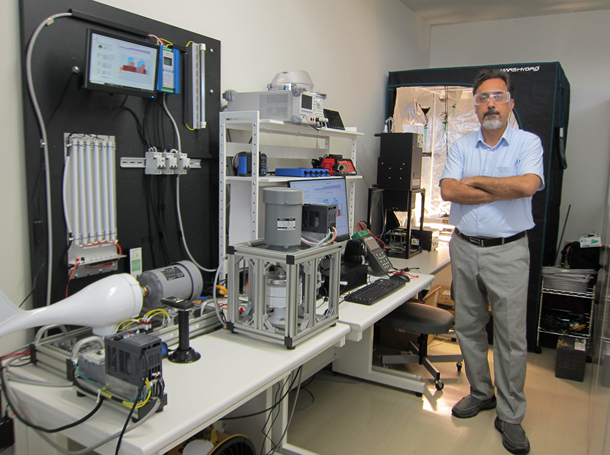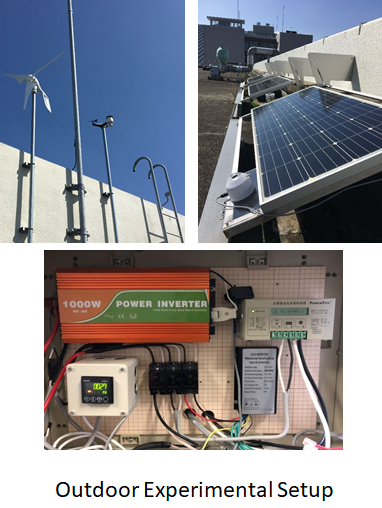研究成果 Research Results
- TOP
- News
- Research Results
- Getting more power from renewable-based microgrids
Getting more power from renewable-based microgrids
Novel and low-cost control scheme that increases power extracted from local renewable sources could help accelerate utilization of renewable energy in buildings 2022.01.31Research ResultsTechnologyEnvironment & Sustainability
A new scheme developed by Kyushu U researchers for controlling the flow of power generated from renewable resources connected in a small-scale, local power grid could increase yearly power production by 2% compared to current systems if applied on the Chikushi campus.
Such improvements are important for increasing the use of renewable energy through so-called microgrids, which can help reduce demand for electricity from traditional power plants and greenhouse gas emissions by buildings toward meeting climate change goals.
Unlike the central power grids that currently serve electricity to numerous customers over vast expanses, renewable-based microgrids independently manage and distribute electricity produced locally from solar, wind, biomass, and other resources for use over smaller areas. They also coordinate energy storage and distribution of additional electricity from the central grid as needed.
Essential to making microgrids work and getting the most power from each installed electricity source are advanced control systems that integrate customers’ electrical usage and keep the generators operating near optimal conditions.
“The output power of a hybrid renewable microgrid varies with environmental conditions such as sunshine, wind, and operating temperature. To extract the maximum power from the microgrid for the conditions at a particular instant of time, we employ maximum power point tracking, or MPPT, techniques. The better the tracking, the more power we can obtain,” explains Hooman Farzaneh, associate professor at Kyushu University’s Faculty of Engineering Sciences.
Through work funded by the Kyushu Renewable Energy Agency, Farzaneh and his team from the Energy and Environmental Systems (EES) laboratory at Kyushu U’s Interdisciplinary Graduate School of Engineering Sciences (IGES) have developed a novel and low-cost MPPT control system that can be applied to a simple renewable-based microgrid consisting of a wind turbine, a solar cell array, and battery storage.
“Many algorithms have been developed to efficiently track the maximum power point, but they generally suffer from two drawacks,” elaborates Farzaneh. “First, the tracking is often slow. Second, intermittency and rapid changes in sunshine and temperature can cause the tracking to oscillate around one of the multiple local peaks of power.”
To overcome these drawbacks, Farzaneh and his team introduced a new tracking scheme based on fuzzy logic control, which provides rapid control and small oscillations once it reaches the maximum power point even under varying weather conditions.
Unlike traditional computer logic that is based on all or nothing conditions, fuzzy logic is more similar to human thinking in that it represents the various states of a system over spectra that can be expressed as words based on rules made by the developers. So, instead of light just being dark or bright, it could be represented as varying degrees of dark, dim, bright, and blinding, and actions can be chosen based on whether it is very dark or a little bright.
Using this approach allowed the tracking control to more rapidly and accurately change the flow of the electricity out of generators depending on weather conditions to keep them running near their maximal power points, resulting in more power output from the microgrid.
In addition to performing modeling and simulations of systems that also control battery charging for energy storage and inverter output voltage and frequency for meeting the AC load requirements, the reseachers tested and validated the developed control system using an outdoor hybrid renewable test setup located on the Chikushi campus.
Based on tests considering a sunny, cloudy, and rainy day in each month in 2020, the researchers confirmed the better performance of their system in a variety of climates.
Compared to existing commercial systems on the market, Farzaneh and his team estimate that their proposed MPPT can realize an extra 26.2 kWh of electricity per year from each kilowatt of installed capacity of solar panels on the Chikushi campus—corresponding to a 2% increase in power production.
“While costs are important, the advantage of using such MPPT can facilitate the rapid deployment of hybrid renewable-based microgrids in the residential sector in Japan,” says Farzaneh.
The researchers are now more accurately analyzing the system using a new indoor microgrid test system, which includes an artificial solar power simulator and wind turbine emulator, that they constructed to allow them to take into account sudden changes in sunlight and wind speed.
###
For more information about this research, please see the following publications.
“Techno-economic analysis of a fuzzy logic control based hybrid renewable energy system to power a university campus in Japan,” Tatsuya Hinokuma, Hooman Farzaneh, and Ayas Shaqour, Energies 14, 1960 (2021). https://doi.org/10.3390/en14071960
“Power control and simulation of a building integrated stand-alone hybrid PV-wind-battery system in Kasuga City,” Ayas Shaqour, Hooman Farzaneh, Yuichiro Yoshida, and Tatsuya Hinokuma, Energy Reports 6, 1528–1544 (2020). https://doi.org/10.1016/j.egyr.2020.06.003
Research-related inquiries
Hooman Farzaneh, Associate Professor
Department of Advanced Environmental Science and Engineering, Faculty of Engineering Sciences
Contact information can also be found in the full release.
- TOP
- News
- Research Results
- Getting more power from renewable-based microgrids

































